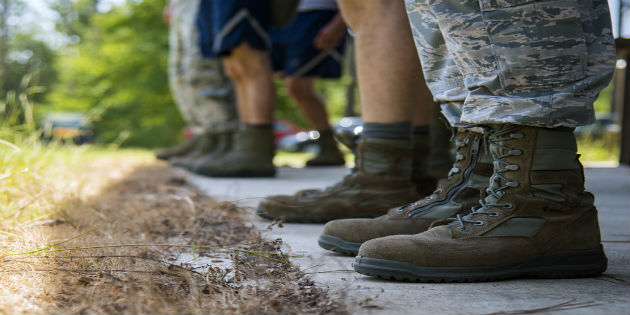Airmen from the 23d Civil Engineer Squadron, stand in line prior to a Chemical, Biological, Radiological, Nuclear and Explosive (CBRNE) Olympics, June 21, 2018, at Moody Air Force Base, Ga. Moody held its first CBRNE Olympics to further Airmen’s overall knowledge on all of the aspects of CBRNE through a new method that was meant to establish a sense of competition and camaraderie. (U.S. Air Force photo by Airman 1st Class Eugene Oliver)
Moody Air Force Base Press Release:
By Airman 1st Class Eugene Oliver, 23d Wing Public Affairs
MOODY AIR FORCE BASE, Ga. — For the first time, Airmen from Moody’s 23d Civil Engineer Squadron (CES) competed against each other to enhance their chemical, biological, radiological, nuclear and explosive (CBRNE) capabilities during a CBRNE Olympics, June 21, here.
During the competition, CES Airmen from all career fields built camaraderie by relying on their teammates to accomplish their objective of staying mission ready.
“CBRNE is continuing to become more pertinent across the military,” said Tech. Sgt. Anna Olson, 23d CES NCO in charge of Emergency Management, Plans, Education and Training. “In the military, things can change at a moment’s notice and not being prepared to deploy at a moment’s notice is unacceptable. Right now, we might be teaching CBRNE through a competition but once our Airmen deploy it’s no longer a game and they need to be ready for anything that can be thrown at them.”
The CBRNE Olympics were meant to provide CES Airmen with a further understanding on the comprehensive world of CBRNE, but Olson explained the importance of all military members being knowledgeable on the dangers and aspects of CBRNE.
“We wanted to change how we taught CBRNE by adding a team building element to it to help encourage Airmen to spread their CBRNE knowledge amongst each other,” said Olson.
The Airmen were evaluated on their ability to complete various tasks in a timely and efficient manner. They used their Olympic heroics to identify and document unexploded ordnances, properly don mission-oriented protective posture (MOPP) gear, successfully complete post-attack reconnaissance routes and build an Alaskan Small Shelter System.
“We intentionally constructed the teams to have a good mix of Airmen ranging from junior enlisted to Senior NCO,” said Olson. “These Olympics consisted of many tasks and challenges that the younger Airmen may not be familiar with so we expect the senior members of the team to step up and properly guide them to the finish.”
The Airmen were not only timed but each team was evaluated on their ability to properly complete each task with minimal mistakes.
“Competing against Airmen from within our squadron really raised the ante for us to provide an extra motivation for us to finish first,” said Airman 1st Class Phillip Pham, 23d CES engineering assistant. “I’ve done CBRNE training before, but I think an event like this really adds an extra challenge that really drove me to try my hardest.”
Olson said that the squadron’s goal with the Olympics was to provide a new way for Airmen to learn the vast world of CBRNE while also giving them an extra incentive to prevail over their fellow Airmen.
“I could see the desire and ambition in every Airman to not only learn but to compete and go that extra mile to finish,” said Olson. “We’re very encouraged by the results and I’m excited to eventually have all of Team Moody’s Airmen complete these Olympics.”
The 23d CES is scheduled conduct their second CBRNE Olympics on July 19.











